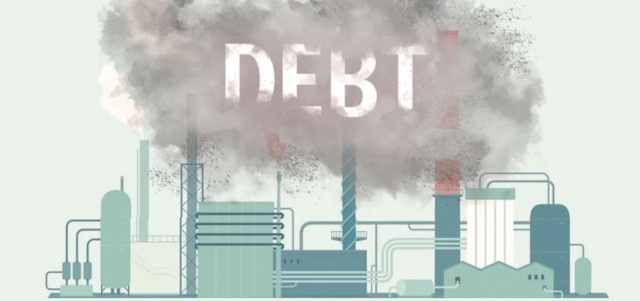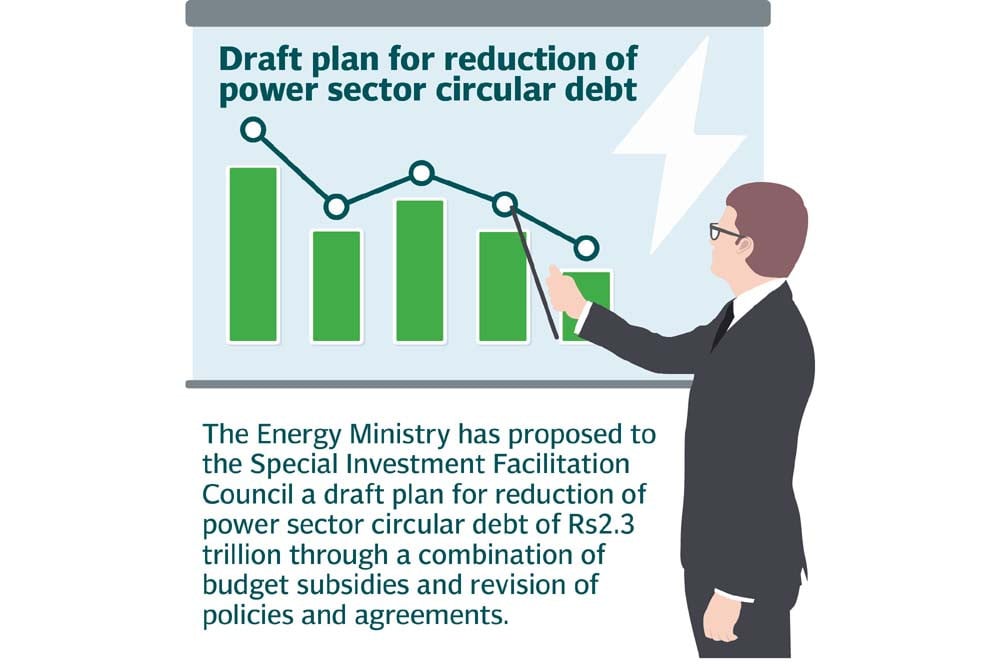Plan prepared for cut in circular debt
Ministry proposes debt reduction via subsidies, revision of policies and deals

The Ministry of Energy has proposed to the Special Investment Facilitation Council (SIFC) a plan for reduction in power-sector circular debt of Rs2.3 trillion through a combination of budget subsidies, revision of policies and agreements.
The draft plan has been shared with a committee of the civil-military forum, which will be further fine-tuned in consultation with the Ministry of Finance, according to government sources. A follow-up meeting has also been held recently between the finance and energy ministries.
But interim Finance Minister Dr Shamshad Akhtar has refused any further “fiscalisation” of power-sector losses through budget subsidies.
Over the years, the energy ministry has availed subsidies of trillions of rupees to keep afloat the power sector that is bleeding due to high losses, low recoveries, unbudgeted subsidies and faulty agreements.
The circular debt stood at Rs2.31 trillion as of June this year, which includes commercial banks’ debt of Rs765 billion parked in the government holding company.
Read A debt-free PIA to go under the hammer
For the current fiscal year, the Ministry of Finance has set aside Rs976 billion in subsidies to maintain the debt at the current level of Rs2.31 trillion in line with an agreement with the International Monetary Fund (IMF).
The executive committee of SIFC had reviewed the initial plan and instructed the energy ministry to evaluate the options in light of “IMF conditions”. The final plan is expected to be shared with the executive committee in the next meeting, subject to endorsement of the finance ministry.
The initial draft suggested that the energy ministry proposed to make the entire commercial banks’ debt of Rs765 billion part of the public debt. The PTI government had also decided to make the debt of Rs565 billion part of the public debt, which would be retired on maturity. Over the past three years, about Rs250 billion has been settled on maturity of the loans.
However, the Rs200 billion raised through Islamic bonds in 2020 is not part of the debt. Sources said that the energy ministry proposed to make that loan part of the public debt but the Ministry of Finance was not receptive to it.
The revised Circular Debt Management Plan was already under implementation and the Ministry of Finance was making timely payments to keep the circular debt within agreed limits, said Qamar Abbasi, a spokesman for the Ministry of Finance.
The spokesman said that any additional financial needs beyond the fiscal year’s commitments would be reviewed at the time of next year’s budget.
Read more PM seeks to tame high inflation with fuel price cuts
The energy ministry is also seeking fiscal space over a period of three years to pay interest on delayed payments to independent power producers (IPPs). It proposed to the SIFC that about Rs237 billion in interest payments should be picked by the Ministry of Finance over the next three fiscal years. But the ministry has not yet agreed to it.
The government has already slapped a debt servicing surcharge of Rs3.23 per unit to service the debt parked in the holding company. But it does not cover the interest being paid to the IPPs on delayed payments.
The Power Division has projected addition of Rs177 billion to the circular debt in the current fiscal year on account of interest payments.
It estimated that it would face a loss of Rs387 billion due to less-than-required recoveries and losses in the current fiscal year. The recoveries will be lower by Rs201 billion due to theft and high losses.
But the Power Division’s anti-theft plan has started making some positive impact.
The total estimated financial impact of the anti-theft campaign was Rs38 billion including the second-order impact on theft and recovery of billed amounts during September, said Rashid Langrial, Secretary Power. “It’s exclusive of October whose impact can only be known after the closing of accounts for the month,” he added.
The billed units increased 1.31% in September compared to a year ago. Likewise, the stolen units of electricity dropped 1.47% in September compared to a year ago. All this has translated into better collection that increased to 87% in the month.

design: Ibrahim Yahya
However, the National Electric Power Regulatory Authority (Nepra) sets electricity tariffs on the basis of 100% recovery and the difference goes to the circular debt.
Electricity prices have become unaffordable for the majority of Pakistanis after consistent increase in rates to cover up losses and inefficiencies of the power sector. In July last year, the government raised tariff by Rs7.91 per unit and then jacked it up by another Rs8 per unit from July this year.
The energy ministry has given an option for the settlement of Rs346 billion worth of circular debt through the revision of agreements with K-Electric (KE) and resolution of a dispute over late payment surcharges on non-payments by the country’s largest electricity utility.
The government and KE have not been able to resolve the issue over the past many years.
The energy ministry has also proposed settlement of about Rs120 billion debt through the reconciliation of dues with provincial governments and another Rs26 billion would be recovered from the federal government.
Read Government debt soars to Rs64 trillion
It proposed to the SIFC that energy and finance ministries would jointly work out a plan for retirement of the rest of the circular debt through the sale of power-sector assets.
The interim government has already ruled out outright sale of power distribution companies and is now working on a plan to outsource management control for a period of 20 years.
Although both power and finance ministries have committed to the IMF to keep the circular debt unchanged at current levels, it would be done on the back of budget subsidies.
The circular debt is still projected to increase by Rs545 billion by March 2024 before settling at Rs392 billion by June next year. Sources said that the Rs392 billion increase in circular debt would be adjusted against the reduction in the previous debt stock through subsidies aimed at keeping the total debt at Rs2.31 trillion by June.
Published in The Express Tribune, October 21st, 2023.
Like Business on Facebook, follow @TribuneBiz on Twitter to stay informed and join in the conversation.



















COMMENTS
Comments are moderated and generally will be posted if they are on-topic and not abusive.
For more information, please see our Comments FAQ